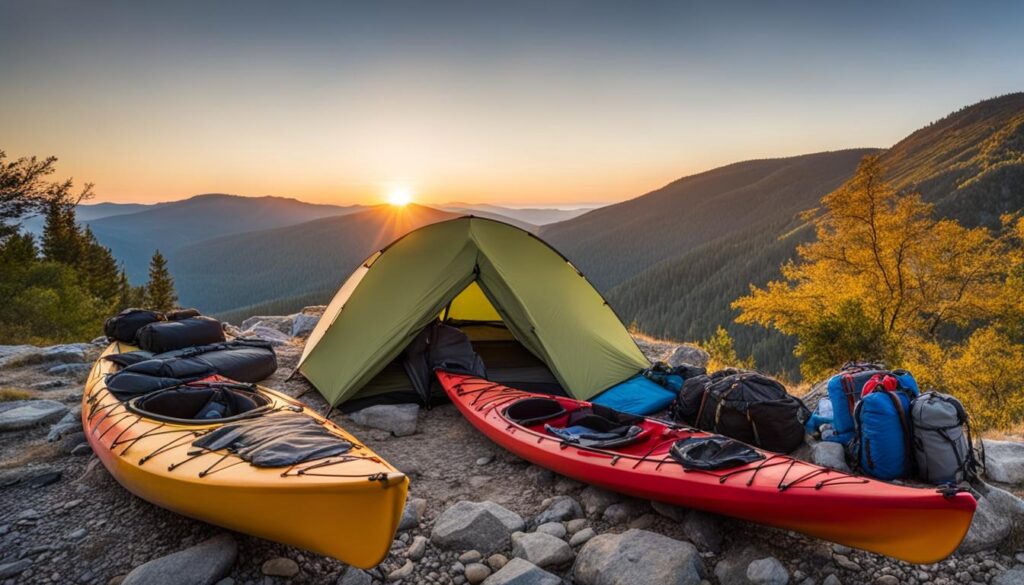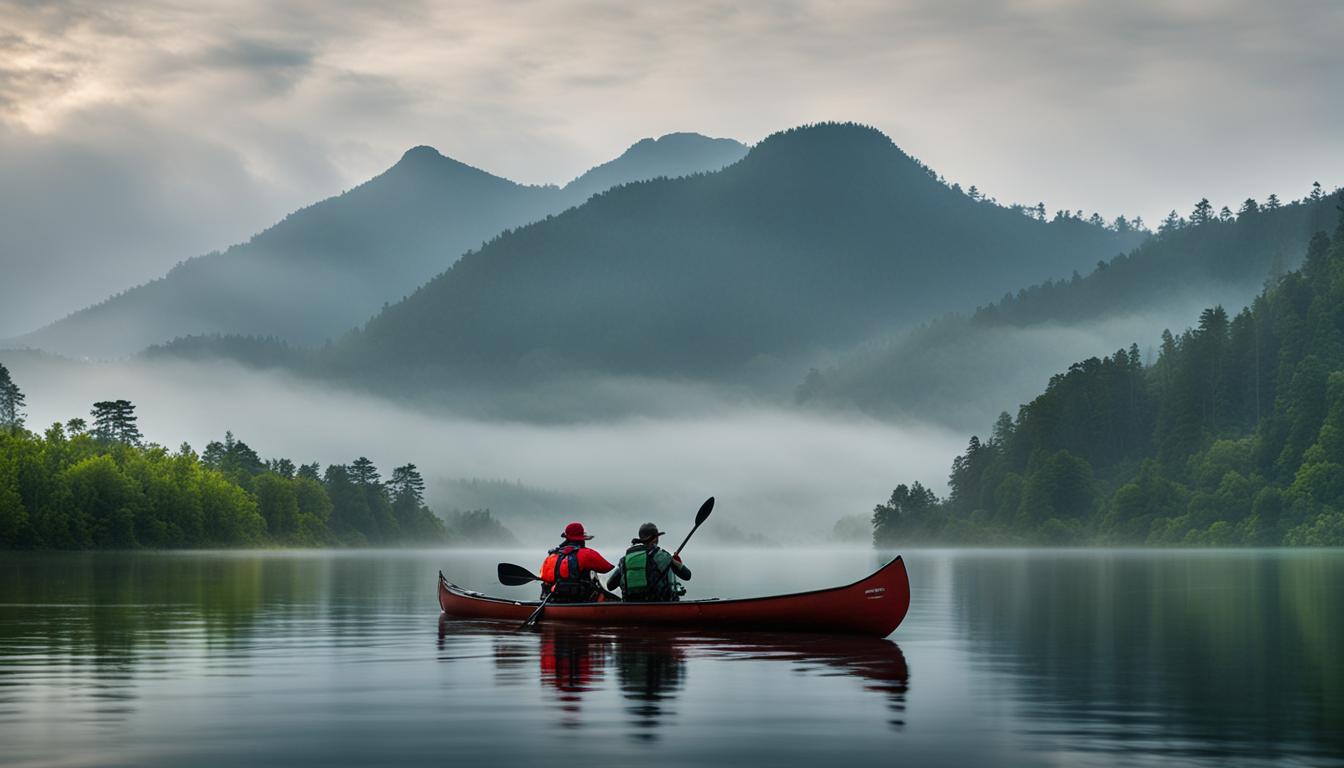Planning a wilderness canoe or kayak trip? Whether you’re exploring the rivers of northern Canada or venturing into the remote wilderness of Alaska, having the right gear is essential for a successful and enjoyable journey. From choosing the right canoe or kayak to packing the necessary items for backcountry portaging, here’s your ultimate guide to wilderness portaging essentials.
Key Takeaways:
- Careful planning and the right gear are essential for wilderness canoe or kayak trips.
- Choose a high-volume canoe or kayak with a spray cover for long trips.
- Pack a netted tarp, powerful stove, bombproof tent, appropriate footwear and clothing, killer rain gear, tools for clearing portages, pot cozies, insulated mug, multiple paddles, and a sharp sheath knife.
- When choosing a canoe or kayak, consider factors such as size, material, and compatibility with transportation methods.
- Invest in a high-quality tent with good ventilation and a spacious vestibule, and choose sleeping gear that provides comfort and insulation.
Essential Gear for Comfort and Safety
When preparing for a wilderness kayak trip, there are key gear items that can enhance your comfort and ensure your safety. It’s important to have the right equipment to protect yourself from the elements and handle any emergencies that may arise during portaging in remote areas.
Protection from Bugs and Wind
A netted tarp is a must-have item for any wilderness kayak trip. It provides protection from annoying bugs and gusts of wind that can make your camping experience uncomfortable. Make sure to choose a netted tarp that is lightweight, durable, and easy to set up.
Shelter and Comfort
A bombproof tent with a large vestibule is essential for your safety and comfort while camping in the wilderness. Look for a tent that is designed to withstand harsh weather conditions and offers ample space for you and your gear. This will ensure that you have a secure and cozy shelter to retreat to after a long day of paddling.
Survival Gear for Emergencies
When exploring remote areas, it’s crucial to be prepared for emergencies. Pack survival gear such as a first aid kit, emergency blankets, a compass, a signaling device, and a reliable multi-tool. These items can be lifesavers in case of unexpected situations.
Choosing the Right Canoe for Wilderness Trips
When embarking on a wilderness kayak trip, selecting the right canoe is essential for a safe and enjoyable experience. The right canoe should be able to carry all the necessary gear and navigate through rapids with ease. It’s crucial to consider factors such as size, material, and compatibility with transportation methods. Here are some key considerations to keep in mind when choosing a canoe for wilderness trips.
Determining the Ideal Size
The size of the canoe plays a significant role in its performance and capacity. For wilderness trips, it is recommended to opt for canoes that are 17 feet long and have a center depth of 14-15 inches. This size provides ample space for gear storage and offers stability in different water conditions. Additionally, look for a high-volume canoe with a spray cover to protect your gear from water and weather elements, especially in challenging river environments.
Material: Durability and Insulation
When it comes to material, there are several options available for wilderness canoes. Canoes made of durable materials such as Royalex, polyethylene, or Innegra are popular choices. These materials provide excellent insulation from cold water, ensuring your comfort during extended trips. Consider the trade-offs between weight and durability when selecting a canoe material, as heavier canoes may be more resilient but can be more challenging to transport.
Essential Design Features
Ensure that the chosen canoe includes essential design features for wilderness trips. Look for a canoe with a padded yoke, which will offer comfort when portaging or carrying the canoe over land. Glued-in knee pads provide additional support and stability while paddling. Lining holes at the cut water, as well as tracking lines, can assist in handling the canoe effectively and maneuvering it through challenging river sections.

| Canoe Material | Durability | Insulation | Weight |
|---|---|---|---|
| Royalex | Durable | Excellent | Medium |
| Polyethylene | Highly durable | Good | Heavy |
| Innegra | Durable | Good | Medium |
Table: Comparison of Wilderness Canoe Materials
By considering these factors, you can choose a canoe that is well-suited for wilderness trips. Remember to prioritize durability, insulation, and design features that enhance your comfort and safety during your adventure.
Essential Tent and Sleeping Gear for Wilderness Camping
When it comes to wilderness camping, having the right tent and sleeping gear is crucial for a comfortable and restful experience. Your tent should provide adequate protection from the elements while offering good ventilation to prevent condensation. Look for a tent with a full rain fly that extends all the way to the ground and a roomy vestibule for storing your gear securely.

Some recommended tent options for remote area kayak portage solutions include the Cannondale Aroostook, Eureka Tundraline (discontinued), and Hilliberg Katum. These tents are known for their durability and ability to withstand challenging wilderness conditions. However, it’s important to choose a tent that suits your specific needs and preferences.
“A good tent is essential for a comfortable and safe wilderness camping experience. Look for one that provides adequate protection from the elements and offers enough space for you and your gear.”
In addition to a reliable tent, your sleeping gear should also be carefully chosen. Consider investing in a high-quality sleeping pad that provides insulation, comfort, and support. Options such as air pads or two closed-cell foam pads are popular choices for wilderness camping.
When it comes to choosing a sleeping bag, make sure it is rated for the expected temperature range of your trip. A bag liner can also be a great addition to your gear as it increases the longevity of your sleeping bag and provides an extra layer of warmth.
Summary:
- Choose a tent with good ventilation, a full rain fly, and a roomy vestibule for storing gear.
- Consider options like the Cannondale Aroostook, Eureka Tundraline, or Hilliberg Katum for durable tent choices.
- Invest in a sleeping pad that provides insulation and comfort, such as air pads or closed-cell foam pads.
- Select a sleeping bag rated for the expected temperature range and consider using a bag liner to increase warmth and longevity.
| Tent Options | Features |
|---|---|
| Cannondale Aroostook | Durable, good ventilation, roomy vestibule |
| Eureka Tundraline (discontinued) | Durable, full rain fly, suitable for wilderness conditions |
| Hilliberg Katum | Durable, good ventilation, roomy vestibule |
Conclusion
When embarking on a wilderness canoe or kayak trip, you need to ensure you have the essential gear for comfort, safety, and convenience. Packing the right equipment will ensure you have a successful and enjoyable adventure in the wilderness.
First and foremost, choosing the right canoe or kayak is vital. Consider factors such as size, material, and compatibility with transportation methods. A well-equipped canoe or kayak will make all the difference in your journey.
Additionally, don’t forget the other essentials. Bring along a netted tarp to protect yourself from bugs and wind, a powerful stove for cooking, a bombproof tent for shelter, and appropriate footwear and clothing to keep you comfortable and safe. Killer rain gear is a must to stay dry in wet weather.
Furthermore, make sure to pack the necessary tools for clearing portages, pot cozies for cooking, an insulated mug for enjoying hot meals, multiple paddles, and a sharp sheath knife for various camp tasks. These items will prove invaluable in the wilderness.
By being well-prepared with the right gear, you’ll have a fantastic experience exploring the wilderness. So, gather your essentials, plan your route, and get ready for an unforgettable adventure in the great outdoors!
FAQ
What gear is essential for canoeing wilderness rivers in northern Canada and Alaska?
Essential gear includes a high-volume, carefully outfitted canoe with a spray cover, a netted tarp for bug and wind protection, two identical powerful gasoline stoves for cooking, a bombproof tent with a large vestibule for shelter, neoprene boots and warm wool clothing for comfort, killer rain gear, tools for clearing portages, pot cozies, an insulated mug with a cover, two paddles per person, and a sharp sheath knife.
What gear is essential for kayaking in the wilderness?
Key gear items for wilderness kayak trips include a netted tarp for bug and wind protection, a bombproof tent with a large vestibule for shelter, neoprene boots and warm wool clothing for comfort, killer rain gear to stay dry, tools such as a hatchet and folding saw for clearing portages, pot cozies and an insulated mug with a cover for cooking, two paddles per person, and a sharp sheath knife for various camp tasks. It’s also important to bring survival gear for emergencies during portaging in remote areas.
What should I consider when choosing a canoe for wilderness trips?
When selecting a canoe, opt for a high-volume, highly rockered canoe with a spray cover for carrying gear and navigating rapids. Canoes that are 17 feet long and have a center depth of 14-15 inches are ideal. Look for canoes made of durable materials like Royalex, polyethylene, or Innegra for insulation from cold water. Other important features include a padded yoke, glued-in knee pads, lining holes at cut water, and tracking lines. Additionally, consider compatibility with float planes for transportation purposes.
What tent and sleeping gear is essential for wilderness camping?
Choose a tent with good ventilation, a full rain fly, and a roomy vestibule for gear storage. Recommended tent options include the Cannondale Aroostook, Eureka Tundraline (discontinued), and Hilliberg Katum. For sleeping pads, select options that provide insulation and comfort, such as air pads or two closed-cell foam pads. Use a sleeping bag rated for the expected temperature range and consider using a bag liner for added warmth and longevity. Don’t forget to pack a pillow for added comfort during sleep.
How important is having the right gear for wilderness canoe or kayak trips?
Having the essential gear is crucial for comfort, safety, and convenience during wilderness canoe or kayak trips. It includes a well-equipped canoe or kayak, netted tarp, powerful stove, bombproof tent, appropriate footwear and clothing, killer rain gear, tools for clearing portages, pot cozies, insulated mug, multiple paddles, and a sharp sheath knife. Choosing the right canoe or kayak is essential, and having high-quality tent and sleeping gear greatly enhances camping comfort. Being well-prepared with the necessary gear ensures a safe and enjoyable wilderness adventure.





